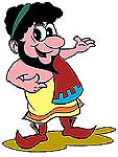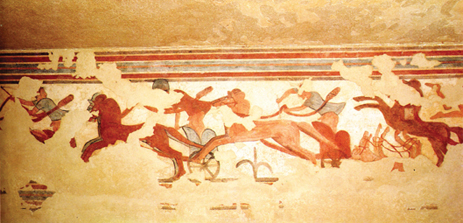

Scene di giochi atletici dalla Tomba delle Olimpiadi a Tarquinia Fine del VI secolo a.C.
In the rural areas near the cities or sacred areas, athletic and gladiator games were held in temporary wooden structures, no traces of which remain. A large public, made up of people from all social classes and both men and women, gathered for all these events. We have an accurate idea of these events from the vast iconography that has come down to us in the tomb paintings.
Under the leadership of a judge, whose authority was symbolized by the same curved stick as used by the priests, the “lituo”, the athletes competed in the most popular sports of the ancient Mediterranean civilizations, namely throwing the discus and the javelin, wrestling, boxing, running, high-jumping, pole-vaulting, running in fighting gear and horse-racing. The most popular sport however was chariot-racing, with the enthusiasm of the public reaching levels of fanaticism.
Great honours were showered on to the winners of the contests, who received prizes proving their athletic worth before the magistrates of the city. The gladiators’ games also probably attracted large and demanding audiences. Fighting went on until the last drop of blood was spilled by slaves, generally prisoners of war, using a variety of arms and trained in special schools. As well as men fighting one another, men fighting wild animals was also common.